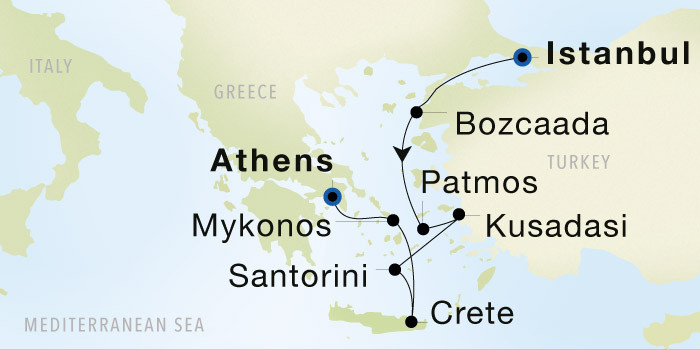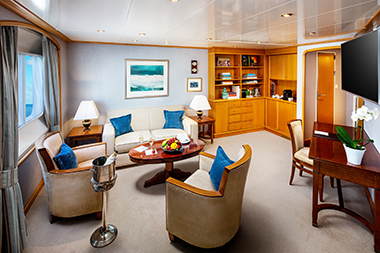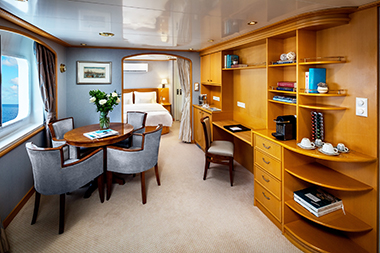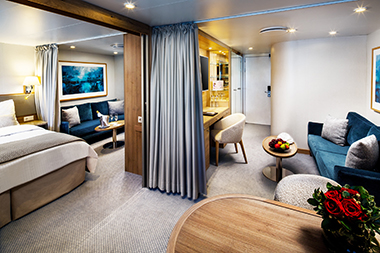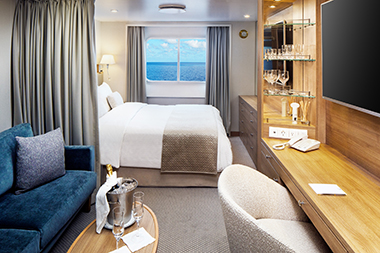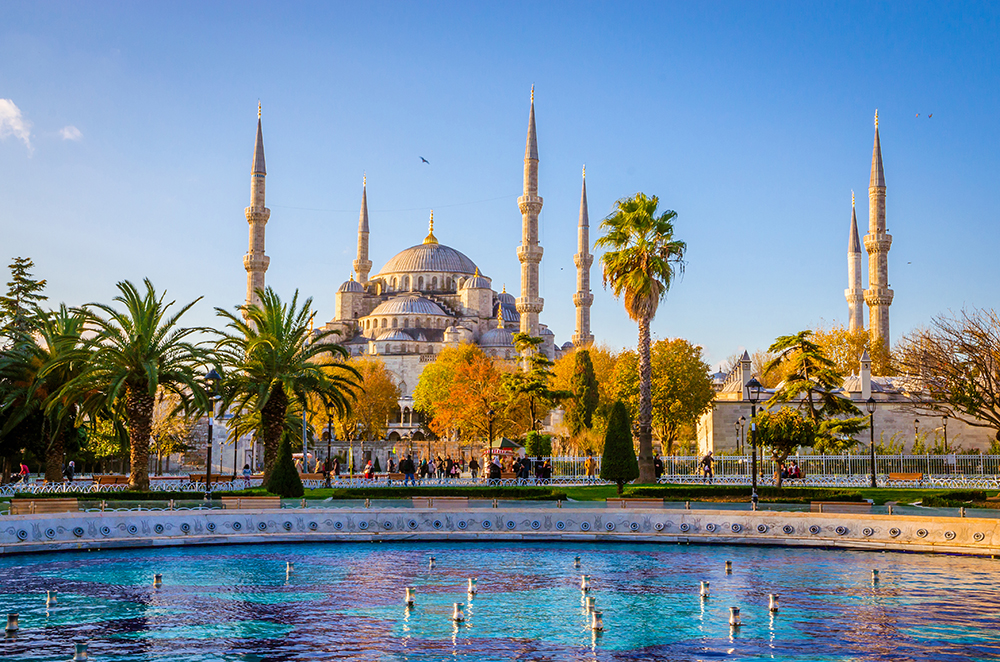
A transcontinental city straddling the Bosporus, one of the world's oldest waterways in northwestern Turkey, Istanbul has often been described as the destination where “East Meets West.” Its nickname comes from its most defining feature, the Bosporus Strait, which divides the European and Asian sides of the city, revealing a vibrant meld of cultures, architectural styles, and cuisine. Selected as a European Capital of Culture for 2010, Istanbul is home to some of the world’s most famous mosques, churches, and palaces, as well as being an important city during the Latin, Byzantine, and Ottoman Empires.
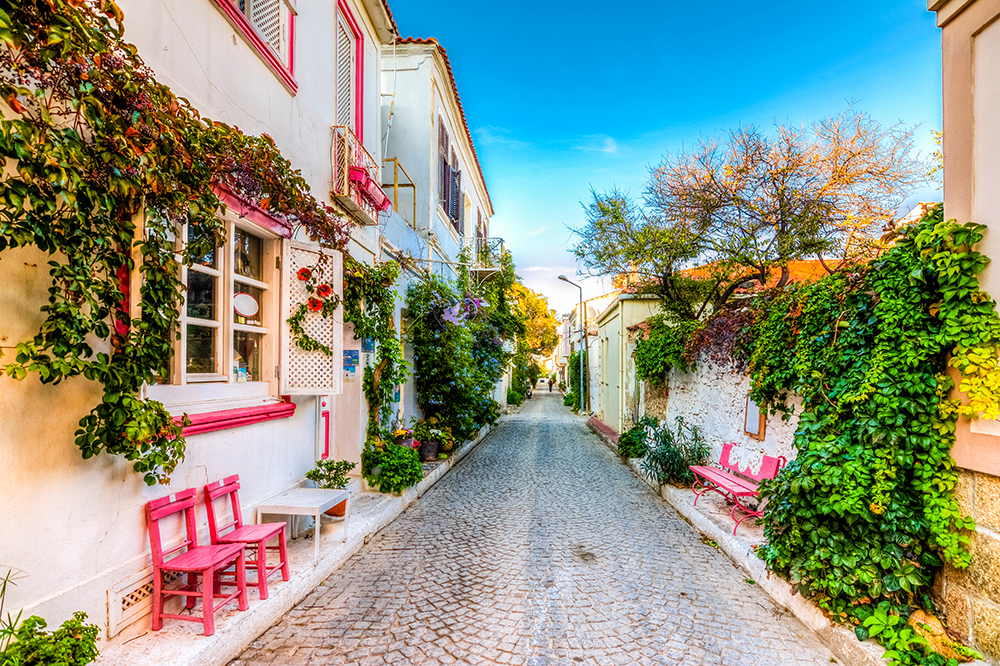
Bozcaada is the contemporary Turkish name for the legendary island of Tenedos, named after the legendary hero Tenes, who ruled the island at the time of the Trojan War. Sparsely populated and dotted with vineyards, the island’s main industries are fishing and winemaking, making it the perfect place to explore its vibrant markets, open-air cafés, and picturesque vineyards. The beaches on this tiny island, such as Ayazma Plaji and Akvaryum Koyu, are only known to locals and those that covet this beautiful coastline. For nature lovers and history buffs, hike to 15th-century Bozcaada Castle, one of Turkey’s best-preserved fortifications, offering incredible views, or visit the Koprulu Mehmet Pasa Mosque, restored in 1655.
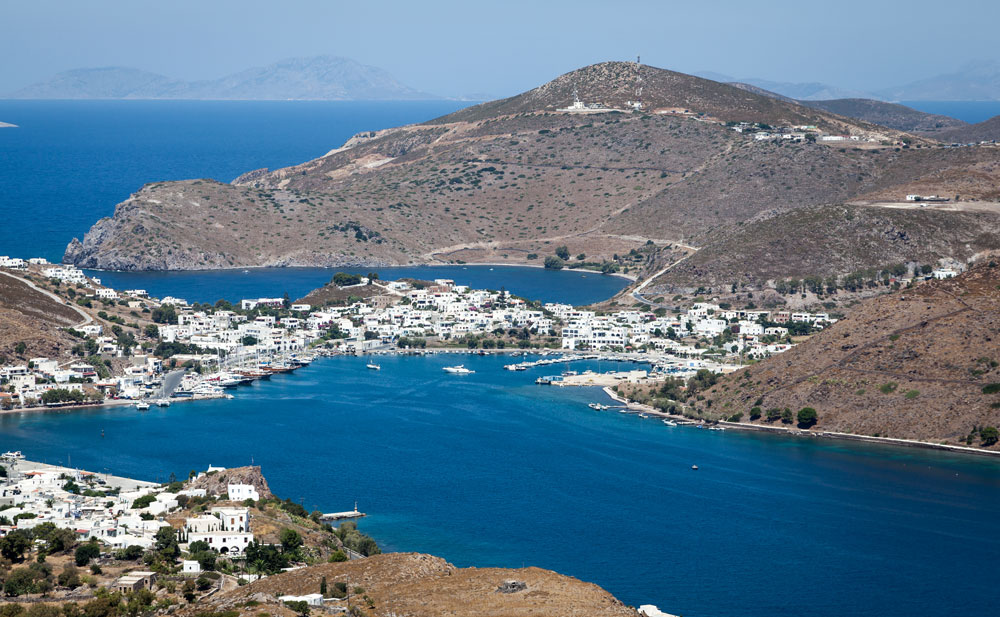
Patmos is in the South Aegean Islands, particularly a member of the Dodecanese Islands of Greece. It is north of Leros and is most known for its connection to John the Apostle from the Book of Revelations; therefore Christian pilgrims frequent this destination. In mythology, Patmos was named “Letois”, which is another named for the goddess Diana, Leto’s daughter. Since ancient authors seldom mention Patmos in early text, information on early inhabitants is limited. It is widely believed the original people of Patmos were the Carians from Asia Minor, as discovered by the earliest archaeological findings date back to the Bronze and Mycenaean periods. The mountain in the country of Caria was named Latmos, which is where historians believe the name Patmos is derived from. Dorians also colonized in Patmos, and over time, Ionians followed suit. The primary port in Patmos is Skala, which was one of the most important sea ports in the Mediterranean around the 16th century. Early Christian basilicas were constructed in the name of John of Patmos, however between the 7th and 9th century when Saracen attacks were still problematic, the Grand Royal Basilica was destroyed. A monastery began construction in 1101 when Christodoulos assumed authority over Patmos. The population began expanding as immigrants from the fall of Constantinople and Candia to place in the 15th and 17th centuries, respectively. The island was under the Ottoman rule for years and was interrupted by Venice during the Candian War, Russia during the Orlov Revolt, and Greece during their War of Independence. During the Italo-Turkish War, Italy occupied Patmos until 1943, when Nazi Germany held power over the island until 1945. Since Patmos rejoined in 1948, it has become the tranquil and frequented destination it is now. Tourists visit the Monastery of St. John, Chora, the Cave of Apocalypse, Psili Ammos Beach and other beautiful points of interest in “Europe’s most idyllic place to live,” as named by Forbes in 2009.
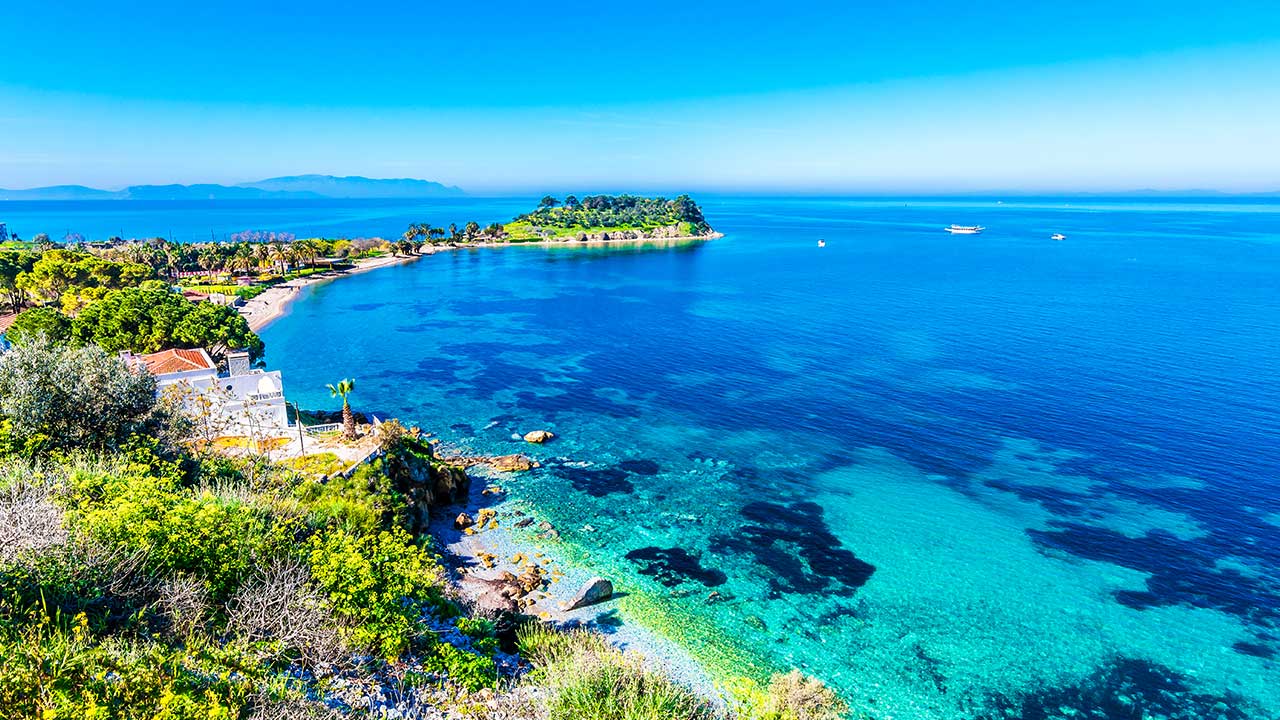
Kusadasi is a beach resort town on Turkey’s Aegean coast and the center of the seaside district of the same name in Aydin Province. The seaside town is also your gateway to the classical ruins at nearby Ephesus, among the world’s best preserved ancient Greco-Roman remains, including its excavated Terrace Houses and House of the Virgin Mary. Kusadasi’s seafront promenade, marina, and harbor are lined with quaint restaurants. Just offshore on Pigeon Island stands a walled thirteenth-century Byzantine castle that once guarded the town. Meet resident wild boars at nearby Dikek National Park, comprised of four secluded beaches, a spectacular coastline, and incomparable views of the Aegean Sea, just one of Turkey’s many protected conservation areas.
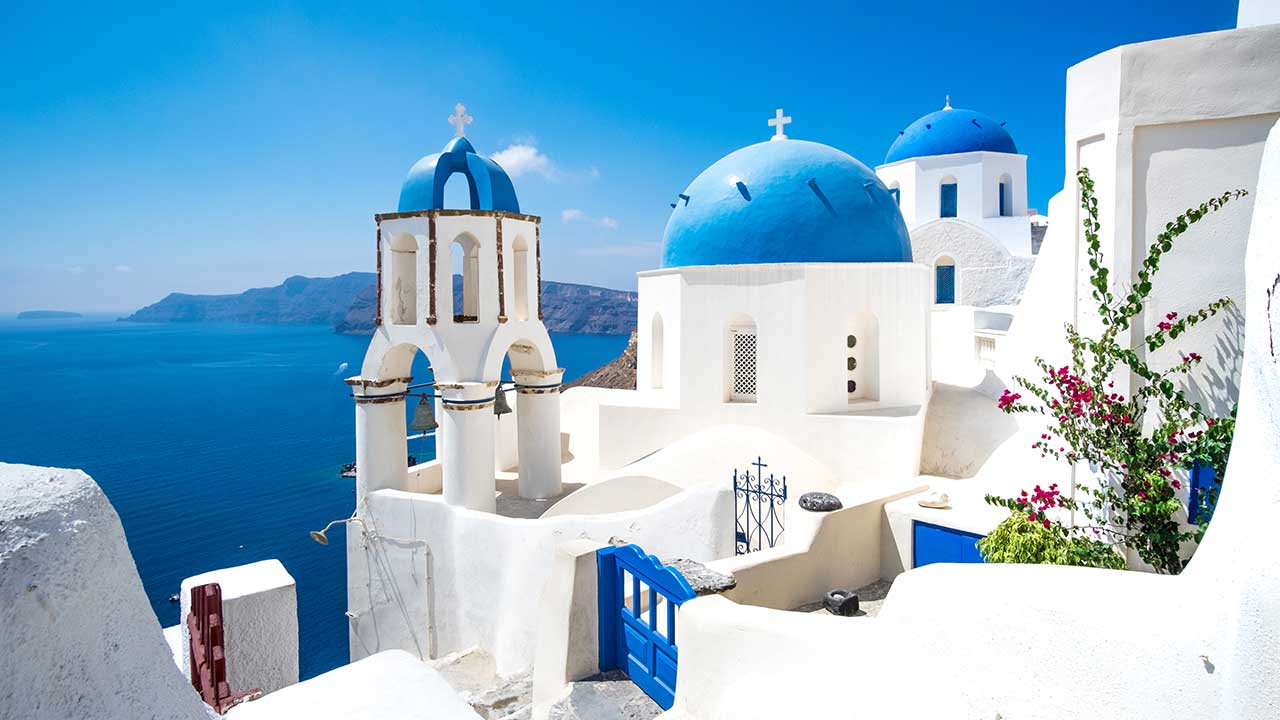
Santorini, officially named Thira, is the southernmost Greek island that is within the Cyclades archipelago, in the southern Aegean Sea. Part of the regional unit Thira, the municipality of Santorini is comprised of the island Santorini, Therasia, and other uninhabited islands of Christiana, Palaia Kameni, Aspronisi, and Nea Kameni. The geological history of Santorini is quite complex due to the area’s volcanism and is currently a water-filled caldera: a rectangular lagoon that is surrounded by three steep cliffs. The name Santorini is a contraction of the name Santa Irini, which is based on an ancient cathedral found in the island’s village of Perissa. This name was given by the Latin Empire in the 13th Century. During the Ottoman Empire, Santorini was called “Santurin” or “Santoron”, and in early times, it was named Kalliste, Strongyle, and Thera. Santorini is the site of the Minoan Eruption (also known as the Thera Eruption), one of the largest eruptions ever in recorded history. The origins of Plato’s story of Atlantis is believed to have a connection to this eruption that destroyed the early settlements on what was formerly a single island. The descriptions found of Plato’s Atlantis strongly resembles Thera, and with seismological, archaeological, and volcanological evidence, these claims are further supported. There is also speculation that the eruption is related to the Exodus of the Israelites, as well as causing the plagues described in the Bible in ancient Egypt. The economy is sustained by two principal industries: tourism and agriculture, and has recently been voted as one of the world’s most beautiful islands in various outlets such as the Traveler’s Choice Awards in 2015. The wine industry in Santorini is becoming more relevant as well, made up of Assyrtiko, Athiri and Aidani grape varieties, which is best exemplified in Vinsanto (“holy wine”) which contains all three Aegean varietals. Although Santorini is highly arid, it’s unique ecology and climate allows it to grow unique and prized produce, such as cherry tomatoes, Lathyrus clymenum (a legume), and capers. Thus, tourists indulge in local specialties such as Brantada, Fava, and the traditional dish Santorinio Sfougato.
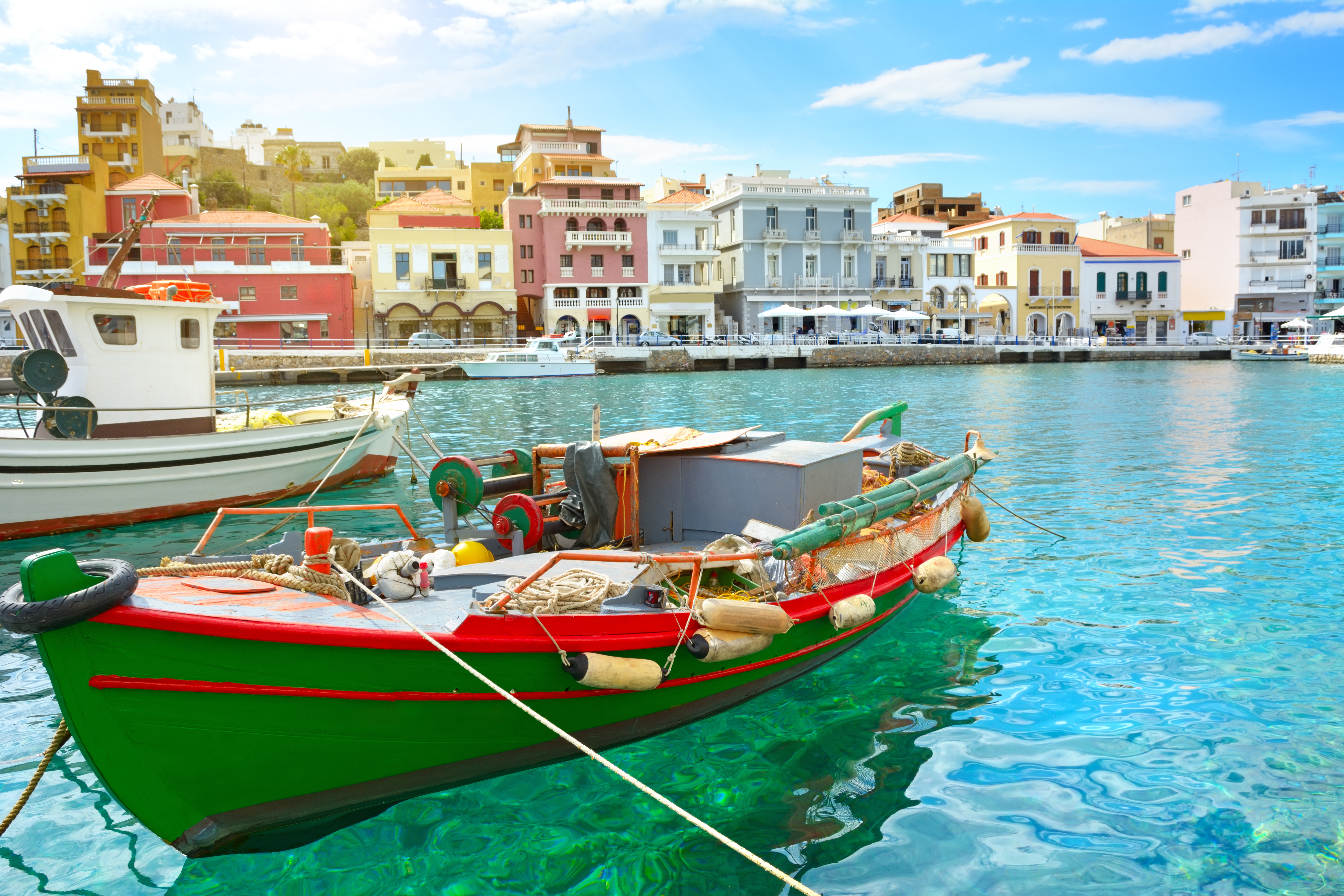
Located in the southern part of the Aegean Sea, Crete features abundant natural beauty, intricate architecture, and archaeological sites worthy of exploration. In the old port, visit Castello a Mare, a Venetian fortress, and the Palace of Knossos, one of the largest and most significant Bronze Age finds in the region. Tucked away in eastern Crete’s Gulf of Mirabello, the small town of Agios Nikolaos occupies the site of the ancient city of “Lato pros Kamara” which was the port of the city “Lato pros Etera,” a city that flourished during the Archaic and Classical Age as well as during the Roman era. Agios Nikolaos grew up around a picturesque saltwater lake connected to the sea by a narrow channel. Steeped in myth, the lake is said to be bottomless as well as the legendary bathing spot of the goddesses Athena and Artemis. Today, tavernas serving freshly caught seafood line the stone path that encircles the lake. Snug beaches such as Kitroplatiea and Amnos break up the town’s waterfront, providing views across the glittering gulf. In true SeaDream style, we anchor in the bay, and tender guests into the heart of town.
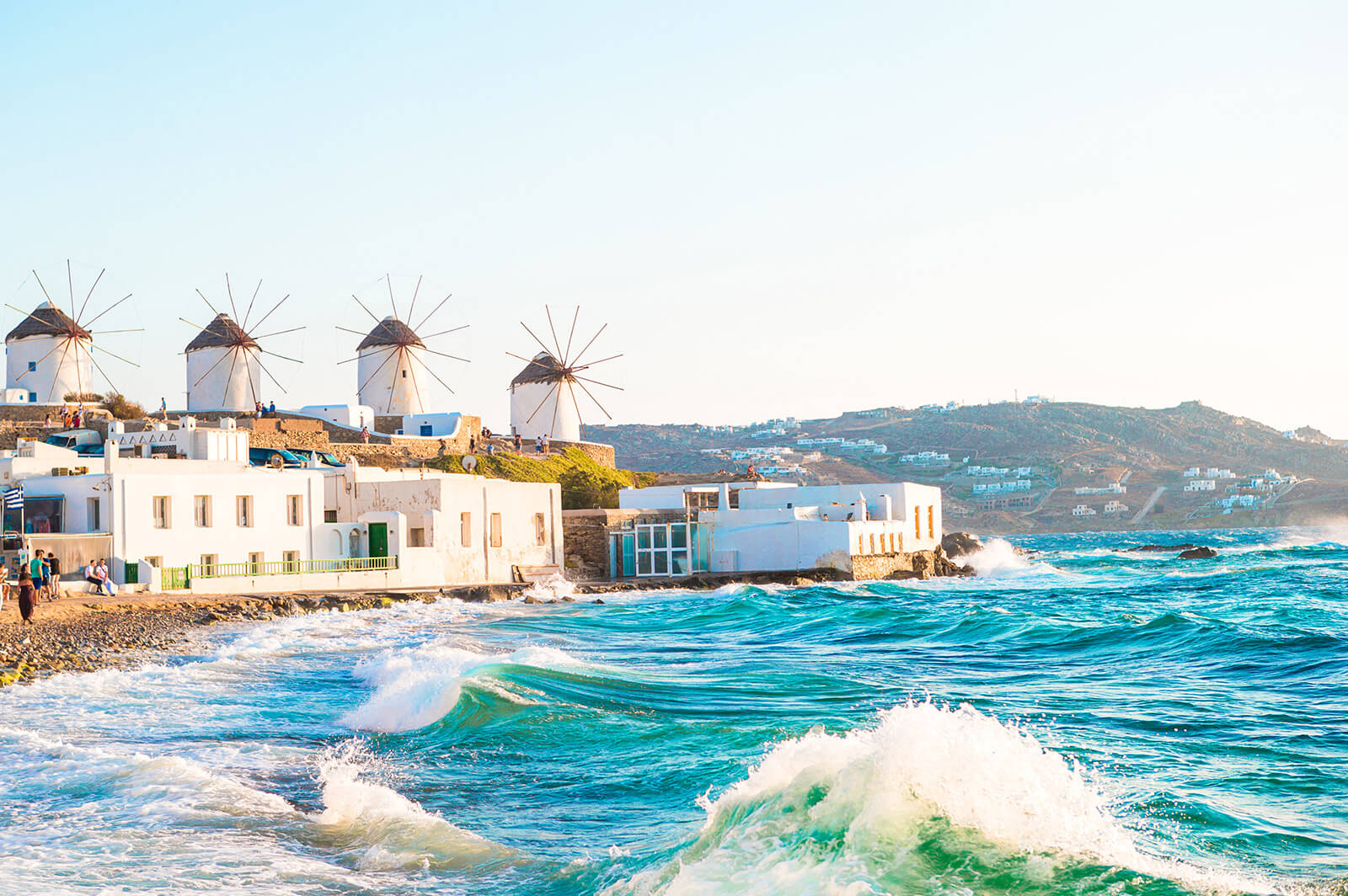
Mykonos is one of the most visited Greek Islands. It is part of the Cyclades group and lies between Tinos, Syros, Paros and Naxos. The island spans an area of 85.5 square kilometers (33.0 sq mi) and rises to an elevation of 341 meters (1,119 feet) at its highest point. Mykonos is so incredibly beautiful; it is not surprising that it has become one of the most desired destinations in the world. When you also add the cosmopolitan lifestyle, the sophisticated nightlife and the historical treasures of the nearby UNESCO Awarded Delos you’ll have the recipe for an unforgettable holiday. SeaDream usually anchors just of the famous windmills and tenders directly to the old town. Guests have a few organized options including the Sacred Island of Delos. Others may simply want to explore the island’s incredible beaches, boutiques, clubs and churches independently.
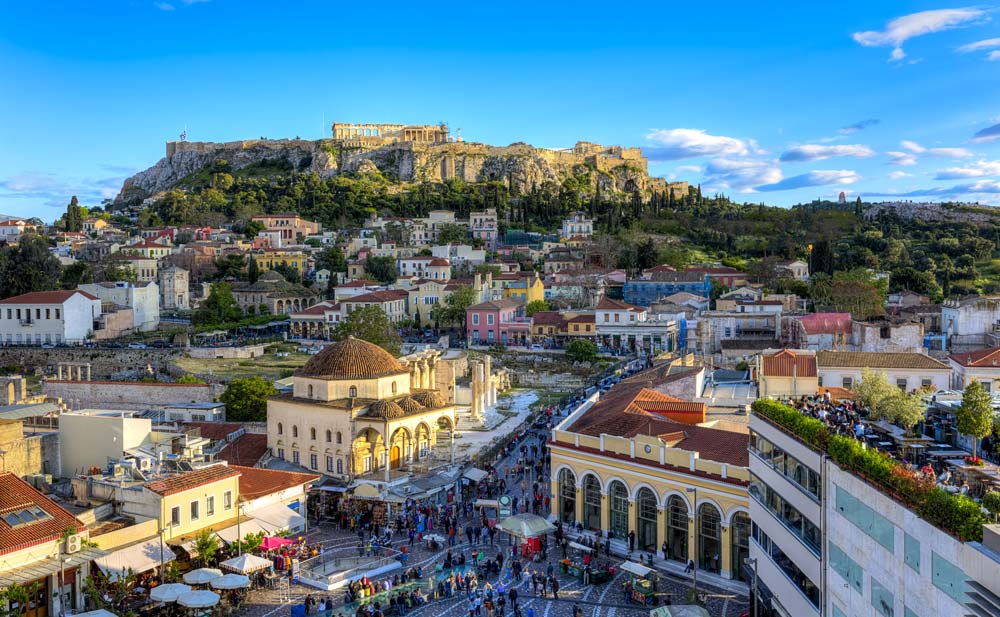
Piraeus, roughly translating to “the place over the passage”, is an important Greek port located within the Athens agglomeration, in the Attica Basin. It is 12 kilometers from the municipality of Athens, considered the fourth largest and is the third most populous amongst all the municipalities of Greece. Now a peninsula, Piraeus, originally a rocky island, was developed in early 5th Century B.C. when it was initially designated as Athens’ import and transit trade port. It is the largest marine-based shipping center of Greece, one of the largest ports in Europe, and considered the second largest passenger port in the world. Inhabited since the 26th Century, it wasn’t until the 6th Century B.C. that Piraeus began catching attention. The land of Piraeus was essentially impassable, flooded by the sea most of the year until centuries passed and the flooding ceased. By the 5th Century B.C. it became a navy base for the Athenian fleet for the natural harbors and the strategic potential they carried. Athenian general and politician Themistocles fortified Piraeus’ three harbors Kantharos, Zea and Munichia, created ship houses and completed his walls in 471 B.C., which led to the port becoming a great military and commercial harbor. There are many archaeological sites, points of interest and entertainment available in Piraeus. Most famous for its tavernas and cuisine, several popular events take place in Piraeus, such as the Ecocinema International Film Festival, the Maritime Festival, the Piraeus Rock Wave Festival and the Three Kings’ Way Festival. There are also many theaters, including the Municipal Theater, the open air Veakeio Theater, and the Menandreio Theater. Museums in Piraeus include the Archaeological Museum of Piraeus, the Merchant Shipping History Institute Exhibition, the Panos Aravantinos Decor Museum, the Georgios Averof Museum Ship and the Museum of Electric Railways. Be sure to catch the panoramic views available from the hill of Kastella, overlooking Athens and the Saronic Gulf!
Suites & Staterooms
*Single Supplement for this voyage is 200% for Yacht Club Deck 2, 3 and 4. For Commodore, Admiral and Owners Suite, a 200% single supplement rate applies.
Government, Port, Document Issuance, Handling & Service fees: $427 per guest (included)
Please Note: Fares are capacity controlled and may change without notice. The fares are per person based on double occupancy. Single and third person rates are also available. SeaDream Yacht Club strongly recommends that all guests purchase travel insurance.
Yachting Land Adventures & Activities
-
Istanbul - Transfers / Private Arrangements / Pre and Post Stays / Accommodations - Istanbul, Turkey
Description
Our Destination Specialists “Tura Turizm” can assist with making your pre-arranged transfers, hotels accommodations and any other personalized pre or post cruise arrangements for your SeaDream cruise embarking, or disembarking, from Istanbul, Turkey.
If you have any questions, please contact Dee at Tura Turizm directly:
Email: dpamir@turaturizm.com
Cell phone: +90 532 465 8151
Address:
Tura Turizm
Harbiye Mh. Cumhuriyet Cad. Elmadağ Han No:32/7
34367 Sisli - Istanbul TURKEYNotes
Duration
N/A hour(s)
Price
(USD)
-
Bozcaada Island - Bozcaada & World Class Vineyard with Wine Tasting
Description
Bozcaada is the third largest island in Turkey; with a rich history and believed to have been established two thousand years ago. It has been captured and destroyed by the Persians, attacked by Alexander the Great, Romans, the Crusaders and soldiers from Venice, Genoa and Byzantines. This Yachting Land Adventure introduces you to Bozcaada’s rich history, plus a visit and tasting of wine at a local vineyard.
Your day starts with a visit of the majestic Bozcaada Castle. The existing castle dates back to Sultan Mehmet the Conqueror’s time when it was rebuilt on the ruins of the prior castle. Walk with your guide to the castle for a panoramic view of the Bozcaada and to learn the castle and village’s history.
Then a short walk through colorful streets brings you to the Bozcaada Museum. On display are fossils found locally, archaeological pieces, coins, articles from French soldiers when they used Bozcaada as a military base in the 1915 Canakkale War, ancient wine bottles produced in the island, the supplies Greek and Turkish people used in their houses.
The islanders of Bozcaada have been engaged in viticulture for centuries. Your next stop will be at the Corvus Vineyards to observe the stages the grapes travel as it is turned into wine. Enjoy a tasting of their local wines a result of the interaction between the inhabitants that have enriched Bozcaada’s cuisine.Notes
A minimum participation is required to operate all Yachting Land Adventures, and some may have limited capacity. All adventures in the SeaDream Yachting Land Adventures program are subject to change. Final departure times will be published on-board. Order of sights visited may vary to avoid congestion. Shade is limited, please dress accordingly. Bring a hat and wear sunscreen. Wear comfortable walking shoes.
Duration
4.5 hour(s)
Price
219 (USD)
-
Bozcaada Island - Stroll through Bozcaada
Description
Journey through the historical gems of Bozcaada, an enchanting Turkish island in the Aegean Sea. Uncover the island's rich heritage as you explore Bozcaada Castle, Bozcaada Museum, Virgin Mary Church, and Alaybey Mosque. This tour promises a blend of ancient architecture, religious significance, and serene moments, making it an ideal destination for history enthusiasts and cultural explorers.
Your day starts with a visit of the majestic Bozcaada Castle. The existing castle dates back to Sultan Mehmet the Conqueror’s time when it was rebuilt on the ruins of the prior castle. Walk with your guide to the castle for a panoramic view of the Bozcaada and to learn the castle and village’s history.
Then a short walk through colorful streets brings you to the Bozcaada Museum. On display are fossils found locally, archaeological pieces, coins, articles from French soldiers when they used Bozcaada as a military base in the 1915 Canakkale War, ancient wine bottles produced on the island, the supplies Greek and Turkish people used in their houses.
Next is a photo stop at The Church of Mother Mary with a fascinating four-storied bell and watchtower. Followed by a visit to the Alaybey Mosque. The mosque, estimated to have been built in the 1700s, has a rectangular structure constructed with the red-cut stones and has a tiled hipped roof in the ottoman style. Enjoy a traditional homemade lemonade, accompanied by a tasty Turkish treat.
Bozcaada is a natural and historical preserved site with two main neighborhoods. See Greek & Turkish architecture and observe the cultural characteristics on your stroll of the narrow cobble stoned streets, and colorful Greek and Turkish houses of Bozcaada.Notes
A minimum participation is required to operate all Yachting Land Adventures, and some may have limited capacity. All adventures in the SeaDream Yachting Land Adventures program are subject to change. Final departure times will be published on-board. Order of sights visited may vary to avoid congestion. Shade is limited, please dress accordingly. Bring a hat and wear sunscreen. Wear comfortable walking shoes. Not suitable for guests with mobility problems.
Duration
3 hour(s)
Price
99 (USD)
-
Patmos - A Photographic View of Patmos
Description
Take the opportunity to capture unique images of Patmos Island and its daily life with your camera.
This tour, covering the south side of the island, not only gives you the opportunity of discovering hidden places but also an opportunity to photograph the most amazing land and seascapes along with developing your creative eye, composing images from geometric form and abstract pattern.
The tour commences from the Port of Skala by minibus to the old village of Chora, the island’s capital, and a photographer’s paradise! The first experience is a wonderful panoramic view over the island. With a turn or your head, you get a glimpse of the 11th century monastery built like a fort, standing with proud dominance. Your guide takes you through Chora’s labyrinth of winding cobbled streets and maze of arched alleyways which offer a feast of photographic inspiration. Observe the settlement of houses dating from the fifteen hundreds with their white-washed walls, reflecting the light, casting shadows and creating geometric patterns. The alleys, arches and doorways display a harmonious balance revealing subtle architectural details which, through your lens, can become exciting atmospheric images trapped in time.
Next, make your way descending to Diakofti stopping off to photograph the view of the mystical rock of Petra and then on to a boatyard. Here you will have the opportunity to photograph the local islanders at work and the streamline shapes of vessels in dry dock. You will also have the chance to enjoy a refreshment at a local café. Fulfilled with great images and pictures in your photo camera you will return to Skala port.Notes
Be sure to wear comfortable walking shoes, as there is extended walking over uneven surfaces and through narrow streets on this excursion. A minimum participation is required to operate all Yachting Land Adventures and some have limited capacity. All adventures in the SeaDream Yachting Land Adventures program are subject to change. Final departure time will be announced on board
Duration
3.5 hour(s)
Price
189 (USD)
-
Patmos - The Monastery of St. John & Patmian House
Description
Explore the UNESCO-listed Monastery of St. John the Theologian, the divine Grotto, and experience a glimpse of a traditional Patmian home.
Patmos is often called the Jerusalem of the Aegean, the sacred island where St. John wrote the Book of Revelations in the Bible. Depart from the pier today for a short scenic ride to Chora and the UNESCO-listed Monastery of St. John the Theologian, built high on an ancient acropolis. The monastery's massive 15th-century walls and 17th-century battlements loom over the town belying an intimate and peaceful interior of arches, inlaid pebble stone floors, and whitewashed buildings. The charming chapel of Christodoulos is profusely decorated with frescoes and the old treasury, now a museum, displays a breathtaking collection of jeweled chalices, crowns, crucifixes, vestments and ancient manuscripts.
Travel on to the Grotto of St. John where the saint heard the voice of God and wrote his revelations. It was here, the most sacred spot on the island, where St. John the Theologian spent 16 months in exile, and this simple cave is now a chapel and place of pilgrimage. Both the Cave and the Monastery have been UNESCO listed in 1999. The iconostases built into the cave depict St. John's visions and the spots where the saint slept, wrote, and heard "a great voice, as of a trumpet."
Back in Chora you will visit one of the traditional Patmian houses, the house of the Simantiris family. The magnificence of Patmian home interiors is stunning. Entering the thick wooden entrance door is like stepping into another dimension, with Venetian style furniture, handicrafts and multi-colored mosaic ceilings dating from the 18th century. After your visit, drive through the town of Chora on the way back to SeaDream in Patmos.Notes
Proper (modest) dress code is required for the monastery and the Grotto. Women should wear skirts covering their knees and blouses covering their shoulders. Men should wear long pants and shirts covering their shoulders. This land adventure includes some uphill walking as well as steps in the upper town of Chora, the local home and at the Grotto. Therefore, flat and comfortable walking shoes are highly recommended.
A minimum participation is required to operate all Yachting Land Adventures and some have limited capacity. All adventures in the SeaDream Yachting Land Adventures program are subject to change. Departures times will be published onboard.Duration
3.5 hours hour(s)
Price
149 (USD)
-
Kusadasi (Ephesus) - Delicious Discoveries and Turkish Cooking Class
Description
Experience the charm of the quaint Greek village of Sirince, followed by a unique culinary workshop set in a stunning Turkish hillside location.
Enjoy a scenic drive to the old Greek Village of Sirince, famous as the perfect synthesis of Turkish and Greek culture, and world-famous Turkish hospitality.
From a distance the village resembles a painting and the winding cobbled streets are lined by two story homes which are under preservation and building is no longer permitted. Stroll through the streets where the houses are kept in Greek style on the outside, while the interiors are distinctly Turkish. Due to its location in a fertile valley the village is renowned for the fresh produce and local olive oil used in the delicious dishes produced there.
Your guide will escort you to the hillside Hotel Nisanyan where you will enjoy the chance to learn about the art and style of Turkish cuisine whilst cooking, chatting, and absorbing the atmosphere of Sirince's special cooking workshop. At the heart of this excursion is the herb garden, and the beautiful hotel which is managed by a renowned family with extensive knowledge of Turkish cuisine, which they love to share. Prepare and cook your own lunch from scratch and later enjoy the dishes you have cooked with your own hands, along with a glass of Turkish wine. Afterwards return to Kusadasi, where you will have the option to take part in a colourful presentation of Turkish carpets or alternatively return to the yacht at your leisure.Notes
A minimum participation is required to operate all Yachting Land Adventures, and some may have limited capacity. All adventures in the SeaDream Yachting Land Adventures program are subject to change. Final departure times will be published on-board.
Duration
5.45 hour(s)
Price
259 (USD)
-
Kusadasi (Ephesus) - Ephesus & the Elite's Terraced Houses
Description
Uncover the UNESCO World Heritage site, Ephesus, on this guided private excursion that also features a visit to the affluent homes at the famous Terrace Houses.
Meet your guide and depart the pier for a scenic drive to the ancient city of Ephesus, one of the largest and most important cities in the ancient Mediterranean world. Second only to Constantinople, it is estimated that roughly 15% of the total city has been excavated. Situated on the western coast of Asia Minor (modern day Turkey), it was one of the oldest Greek settlements on the Aegean Sea and later became the provincial seat of the Roman government in Asia.
Your guided walking tour will start at the upper gate of Ephesus, as you explore the unending monuments including the Forum, the Odeon, the Library of Celsus, Hadrian’s Temple, the Thermal Baths of Scolastika and the Great Theater, built in the Greek era and reconstructed in the Roman period.
You also visit the spectacular Terrace Houses (villas) located on the side of the hill within Ephesus. They have a fantastic view of the entire city of Ephesus. The Ephesus Terrace Houses reveal how wealthy Romans lived during the city’s glory days. Glass floors let you admire geometric mosaics and still-colorful frescoes gleaming on the walls. The Terrace Houses were discovered by a team of Austrian archeologists during excavations in the 1980’s. Along with the ruins in Pompeii, they constitute some of the most vivid examples of Roman domestic architecture to survive today. Reflect on the lives in the city and homes of Ephesus as you return by coach to your yacht in Kusadasi.Notes
This excursion involves extensive walking and stair climbing at the Terrace Houses, comfortable shoes with non-slip soles are recommended. At Terrace Houses, guests will walk on glass-covered platforms. A minimum participation is required to operate all Yachting Land Adventures, and some may have limited capacity. All adventures in the SeaDream Yachting Land Adventures program are subject to change. Final departure times will be published on-board. Order of sights visited may vary to avoid congestion.
Duration
3 hour(s)
Price
169.00 (USD)
-
Santorini - Akrotiri Archaeological Site & Oia Village
Description
On this land adventure, discover the picturesque village of Oia and one of the most important prehistoric settlements of the Mediterranean: Akrotiri Archaeological site. Could Akrotiri be the lost city of Atlantis?
One of the reasons Santorini has attracted the world’s attention is the excavation at Akrotiri, which reclaimed a whole prehistoric Minoan city from the volcanic ash. The prehistoric site of Akrotiri is on the south-western tip of the island and was discovered in 1967 by Professor Spyros Marinatos. The city was buried by the Theran volcanic eruption in the middle of the second millennium BC.
Over the years, excavations have brought into light a remarkably well-preserved site with two and three-story homes decorated with marvelous wall paintings and frescoes, an advanced drainage system and many interesting objects, artwork, pottery and furniture which give a picture of a society which was very well organized and at the peak of prosperity. This was interrupted suddenly by the eruption of the volcano, which buried the entire city. An ambitious modern bio-climatic roof top structure protects this important archaeological settlement where excavation works are still in progress.
After exploring the excavations with a guide, ride to the northeast part of the island and its most picturesque town, Oia. Built high up on the ridge of red rocks, it offers breathtaking views of the blue Aegean. Take a stroll around the narrow streets with the old beautiful houses and the tiny picturesque shops. Enjoy the breathtaking views of the caldera cliff and wander in the narrow streets for shopping or a cup of coffee during your free time in the village.
The guide visit ends in the town of Fira. Wander along the edge of the caldera for amazing views or wander through narrow streets with the various shops. When ready, take a cable car or walk along the path down to the small port of Skala Fira for tenders back to the SeaDream yacht.Notes
A minimum participation is required to operate all Yachting Land Adventures, some have limited capacity. All adventures in the SeaDream Yachting Land Adventures program are subject to change.
Duration
4 hour(s)
Price
179 (USD)
-
Santorini - Islands of Santorini Caldera by Private Catamaran
Description
Cruise the caldera and its volcano on a private luxury catamaran whilst enjoying the stunning views together with refreshments.
Transfer by tender to the pier in Vilhada where the captain and crew wait for your private catamaran cruise. Enjoy wine, beer, soft drinks, and appetizers on board throughout the sailing.
Take in the sea breezes and beautiful views while sailing past Red Beach, White Beach, the rock formations of Akrotiri and the lighthouse. Coming into view next will be the volcanic islands formed around 1570 BC.
Next, disembark and enjoy the beautiful otherworldly surroundings on the island of Nea Kameni. Take the opportunity to relax on the beach or walk up to the island’s crater and visit the natural hot springs, which have waters that are green and yellow due to their mineral content.
After exploring the village, board the catamaran for a journey back to the old port to tender back to the SeaDream yacht.Notes
A minimum participation is required to operate all Yachting Land Adventures and some have limited capacity. All adventures in the SeaDream Yachting Land Adventures program are subject to change. Final departure time will be announced on board.
Hat, sunscreen and good walking shoes are recommended. If you opt to swim in the natural hot springs; please be advised that the mineral content in the water can stain your clothes.Duration
4 hour(s)
Price
549 (USD)
-
Agios Nikolaos, Crete - Knossos Palace
Description
Leave Aghios Nikolaos behind to travel west by motorcoach across the rugged island of Crete to Knossos, the ancient capital of the great King Minos. The Palace of Knossos and labyrinth were supposedly built to confine the mythological Minotaur, a monster born out of the unnatural union between King Minos' queen and a bull. The king is said to have fed his enemies to the Minotaur. It was also in the labyrinth of Knossos that Daedalus and Icarus were confined, the later of whom flew too close to the sun in his attempt to escape. Originally constructed around 1900 BC, the palace was destroyed by an earthquake 200 years later, and was then reconstructed on a grander scale. A final catastrophe occurred around 1500-1450 BC with the eruption of the volcano in Santorini. Despite this blow, habitation continued for another 50 years until a fire swept throughout the city.
Upon reaching the outskirts of Heraklion, visit the renowned archaeological site of Knossos. The guided tour takes includes the fantastic ruins of the ancient palace complex, once the administrative and religious center of the entire region. The Palace of Knossos was excavated and partially reconstructed earlier in the last century by the great archaeologist, Sir Arthur Evans. The restoration work is controversial - it has been criticized for its modernity, yet its nearly complete state allows the visitor to better understand the complexity of the original labyrinth. Visit the living quarters and reception rooms of the king and queen, the store rooms, potters workshops, and the theater. After the visit, board again the coach for the return drive to the pier.Notes
A minimum participation is required to operate all Yachting Land Adventures and some have limited capacity. All adventures in the SeaDream Yachting Land Adventures program are subject to change. Final departures times will be announced on board.
Hats, sunscreen and good walking shoes recommended.Duration
4 hour(s)
Price
169 (USD)
-
Agios Nikolaos, Crete - Spinalonga Island Exploration
Description
Visit Spinalonga Island a former Italian fortress and later a leper colony. Includes a lunch of delicious Cretian specialties and a taste of the famous “Raki” (local spirit).
Depart from Agios Nicolaos port via coach for the beautiful village of Plaka, where a small boat to the island of Spinalonga awaits. The island is located at the entrance of the bay of Elounda, Crete. A former Italian fortress controls the entrance to the bay - one of the last to fall to the Ottoman invaders. The island later became a leper colony for the first half of the 20th century. Today the island is unoccupied, and it is one of the main tourist attractions in the area. Here you will learn about this island on a guided tour, afterwards returning by boat to Plaka.
Upon arrival, in Plaka Village you will enjoy a glass of raki and a Greek lunch at a local tavern. Following lunch, re-board the coach for a drive back to Agios Nicolaos village where you can remain to stroll around the picturesque village on your own or return directly to the yacht.Notes
Flat and comfortable walking shoes are highly recommended. A minimum participation is required to operate all Yachting Land Adventures and some have limited capacity. All adventures in the SeaDream Yachting Land Adventures program are subject to change. Not all of the land adventures shown will be offered on all voyages and departure times are subject to change. Final departures times will be published onboard.
Duration
4 hour(s)
Price
189 (USD)
-
Mykonos - A Relaxing Day at the Beach
Description
Swim, relax and enjoy the beach facilities at one of the most beautiful and sandy beaches of Mykonos Island – Elia beach.
Mykonos is known for its golden sandy beaches and crystal clear waters. Take this opportunity to enjoy some time at one of the famous beaches of the island, the sandy beach of Elia where necessary changing facilities, beach chairs and umbrellas are available. The beach of Elia is fully organized offering also a wide choice of water sports facilities.Notes
Sunscreen and hats recommended.
A minimum participation is required to operate all Yachting Land Adventures and some have limited capacity. All adventures in the SeaDream Yachting Land Adventures program are subject to change. Final departure time will be announced on board.Duration
4 hour(s)
Price
149 (USD)
-
Mykonos - The Sacred Island of Delos
Description
This Yachting Land Adventure arrives at Delos Island by a boat from Mykonos. Delos is the island of lights and the mythical birthplace of the God Apollo. Admire the interesting monument of the Agora, the treasures of the various cities, the theatre and the Sanctuary of Apollo.
Not far from Mykonos lies UNESCO listed Delos, the island of light, the mythical birthplace of the God Apollo and the Goddess Artemis. Its name means “that which appears" and, according to mythology, the island appeared amid the waves so that Leto would have a place to give birth to Apollo and Artemis. Delos Island, an area of only five sq. km (almost 2 sq. miles), was once a very important religious, cultural and commercial center. Today, the island is a piece of land covered with archaeological sites: fallen columns, sections of the famous mosaics which adorned the houses of the rich, a stadium, and tiers of seats from a theatre. Among these ruins, five marble lions in a row still stand. These were the guardians of the sacred lake, still gazing out to the east waiting for the sun to rise.
Other interesting monuments, spread over a wide area, are: the Agora, the treasuries of the various cities, the Sanctuary of Apollo, the Theatre, the Sanctuary of the Foreign Gods and the Sacred Mt Cynthus. Leaving the sacred island of Delos you re-board your local boat for the 45-minute return to Mykonos town.Notes
This land adventure operates from Mykonos only if the yacht does not call at Delos on the same itinerary. This visit includes a two-hour walk across uneven surfaces at the archaeological sites so please wear comfortable walking shoes. The departure time will be adjusted according to the departure time of the local boat schedule from Mykonos to Delos. There is very limited shade at the site so bring protection from the sun. There is a coffee kiosk on the island as well as restrooms near the pier on Delos. A minimum participation is required to operate all Yachting Land Adventures and some have limited capacity. All adventures in the SeaDream Yachting Land Adventures program are subject to change. Departures times will be published onboard
Duration
3,5 hour(s)
Price
139 (USD)
-
Athens (Piraeus) - Transfers / Private Arrangements / Pre and Post Stays / Accommodations - Piraeus (Athens), Greece
Description
Our Destination Specialists “STAT S.A.” can assist with making your pre-arranged transfers, hotels accommodations and any other personalized pre or post cruise arrangements for your SeaDream cruise embarking or disembarking from Piraeus (Athens), Greece.
If you have any questions, please contact STAT S.A. directly:
Email: g.gonis@stathellas.gr (or) d.tatanis@stathellas.gr
Cell phone: +30 6977 90 1956 (or) +30 6983136972
Address:
STAT S.A.
35-39 , Akti Miaouli
Piraeus, GREECE 18535Notes
Duration
N/A hour(s)
Price
(USD)
Prices are per person, in USD. Duration is in hours.
Testimonials
It was truly a Dream voyage!...The food was awesome! Not a single complaint from us! The wines, cocktails and all other beverages were excellent! Peter L. & Hannes K.Sweden
I believe if someone has ever tried travelling with SeaDream at least once he will want to do it gain. John S.Texas
